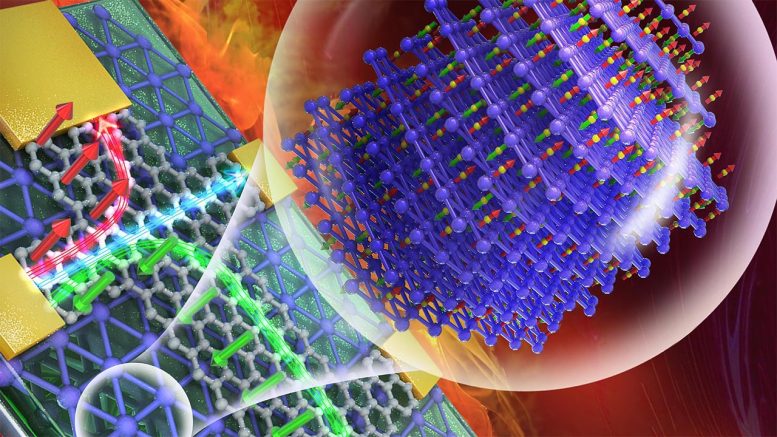
A nanoscale rendering of two materials, graphene (gray) and chromium oxide (blue), that collectively allowed researchers from Nebraska and Buffalo to fabricate a new type of transistor. The red and green arrows represent spin, a magnetism-related property of electrons that can be read as a 1 or 0. Credit: Advanced Materials / John Wiley & Sons, Inc.
Design also poised to save space, retain memory in event of power loss.
A new spin on one of the 20th century’s smallest but grandest inventions, the transistor, could help feed the world’s ever-growing appetite for digital memory while slicing up to 5% of the energy from its power-hungry diet.
Following years of innovations from the University of Nebraska–Lincoln’s Christian Binek and
“The implications of this most recent demonstration are profound,” said Dowben, who co-authored a recent paper on the work that graced the cover of the journal Advanced Materials.
Many millions of transistors line the surface of every modern integrated circuit, or microchip, which itself is manufactured in staggering numbers — roughly 1 trillion in 2020 alone — from the industry-favorite semiconducting material, silicon. By regulating the flow of electric current within a microchip, the tiny transistor effectively acts as a nanoscopic on-off switch that’s essential to writing, reading and storing data as the 1s and 0s of digital technology.
But silicon-based microchips are nearing their practical limits, Dowben said. Those limits have the semiconductor industry investigating and funding every promising alternative it can.
“The traditional integrated circuit is facing some serious problems,” said Dowben, Charles Bessey Professor of physics and astronomy at Nebraska. “There is a limit to how much smaller it can get. We’re basically down to the range where we’re talking about 25 or fewer silicon atoms wide. And you generate heat with every device on an (integrated circuit), so you can’t any longer carry away enough heat to make everything work, either.”
That predicament looms even as the demand for digital memory, and the energy needed to accommodate it, have soared amid the widespread adoption of computers, servers and the internet. The microchip-enabled smartening of TVs, vehicles, and other technology has only increased that demand.
“We’re getting to the point where we’re going to approach the previous energy consumption of the United States just for memory (alone),” Dowben said. “And it doesn’t stop.
“So you need something that you can shrink smaller, if possible. But above all, you need something that works differently than a silicon transistor, so that you can drop the power consumption, a lot.”
‘Now that it works, the fun begins’
Typical silicon-based transistors consist of multiple terminals. Two of them, called the source and drain, serve as the starting and end points for electrons flowing through a circuit. Above that channel sits another terminal, the gate. Applying voltage between the gate and source can dictate whether the electric current flows with low or high resistance, leading to either a buildup or absence of electron charges that gets encoded as a 1 or 0, respectively. But random-access memory — the form that most computer applications rely on — requires a constant supply of power just to maintain those binary states.
So rather than depend on electric charge as the basis of its approach, the team turned to spin: a magnetism-related property of electrons that points up or down and can be read, like electric charge can, as a 1 or 0. The team knew that electrons flowing through